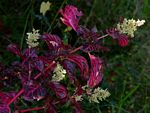Flora of Zimbabwe: Cultivated plants
| Home | > | List of cultivated families | > | Amaranthaceae | > | Iresine |
2339.000 Iresine
Bailey, L.H. (1949) Manual of Cultivated Plants Revised edition. Macmillan, New York.
Bailey, L.H. & Bailey, E.Z. (1976) Hortus Third. A concise Dictionary of Plants Cultivated in the United States and Canada Macmillan Publishing Co, Inc., New York
Description of the genus
Links to cultivated taxa View: living plant images - herbarium specimen images - all images for this genus
| Species | Content |
| herbstii Hook. | Description, Image |
| lindenii Van Houtte |
Other sources of information about Iresine:
Our websites:
Flora of Caprivi: cultivated IresineFlora of Malawi: cultivated Iresine
Flora of Mozambique: cultivated Iresine
Flora of Zambia: cultivated Iresine
External websites:
African Plants: A Photo Guide (Senckenberg): IresineBHL (Biodiversity Heritage Library): Iresine
EOL (Encyclopedia of Life): Iresine
GBIF (Global Biodiversity Information Facility): Iresine
Google: Web - Images - Scholar
iNaturalist: Iresine
IPNI (International Plant Names Index): Iresine
JSTOR Plant Science: Iresine
Mansfeld World Database of Agricultural and Horticultural Crops: Iresine
Plants of the World Online: Iresine
Tropicos: Iresine
Wikipedia: Iresine
| Home | > | List of cultivated families | > | Amaranthaceae | > | Iresine |
